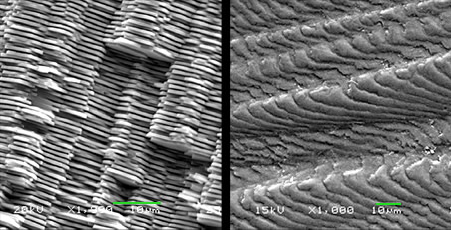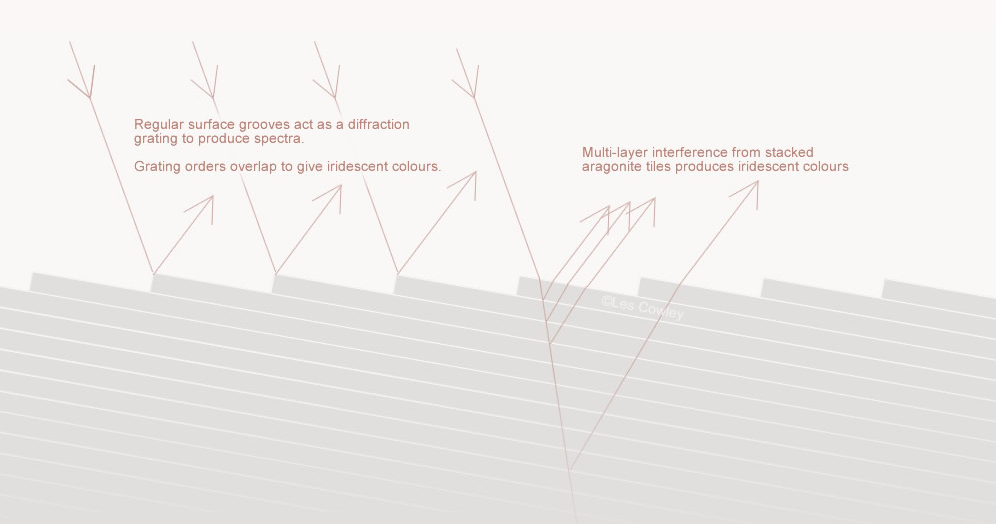Abalone Shell Iridescence
Abalone Shell Iridescence: Exploring the Wonders of Nature's Optical Marvel
When we gaze upon the iridescent colors of an abalone shell, it's hard not to be captivated by its beauty. These captivating hues have fascinated scientists and physicists for centuries, leading to groundbreaking discoveries about the nature of light and the structure of shells. In this article, we delve into the mesmerizing world of abalone shell iridescence, exploring the scientific principles behind its formation and the ongoing research in this field.
Unveiling the Secrets of Sea Shell Colors
One of the early pioneers in unraveling the mysteries of abalone shell iridescence was David Brewster, a renowned physicist and inventor. In the early 1800s, Brewster conducted experiments on the reflection of a candle flame by mother-of-pearl, a material found in sea shells. His observations revealed that the colors exhibited by the shell were not solely a result of reflection and refraction but also involved diffraction. By examining a wax cast of the shell's surface, Brewster discovered that the colors were somehow "communicable." This led him to conclude that the shell's colors were intricately linked to the structure of its surface, which resembled a finely grooved diffraction grating.
Building upon Brewster's findings, Lord Rayleigh, another eminent physicist, expanded the understanding of abalone shell iridescence in 1923. He discovered that many shells contained multiple layers of thin plates, which contributed to their vibrant colors through a phenomenon known as multilayer interference. These layers were inclined to the surface, creating regularly spaced surface grooves where they outcropped. However, it was not until Chandrasekhara Venkata Raman's work in 1934 that these seemingly disparate theories were reconciled. Raman proposed that both surface grooves and internal multiple layers played a role in directing light in the same directions, despite exhibiting different spectra.
Exploring the Optical Properties of Shells in the Modern Era
Even in the 21st century, scientists continue to study the physical structures and optical properties of shells, including the mesmerizing abalone shell. Shells possess remarkable strength and mechanical properties that arise from their intricate internal structure. The colors they exhibit are a prime example of structural color, where light scattering by complex nanostructures creates coloration instead of simple absorption, refraction, or reflection. The study of these natural phenomena not only challenges existing optical theories but also inspires attempts to replicate them.
The lustrous nacre, or mother-of-pearl, found in abalone shells is composed of polygonal tiles made from a hard crystalline form of calcium carbonate called aragonite. These tiles are cemented together in a thin matrix of conchiolin, a combination of polysaccharides and protein fibers. Each tile is a single crystal, tessellated in stacked layers, with each layer measuring approximately 0.5 microns in thickness. The tiles themselves have an average diameter of 10 microns, with their optical axes all perpendicular to the layer.
The regularity of the abalone shell's structure is truly remarkable. Its formation is controlled by protein secretions that govern the nucleation and growth of aragonite crystals. Initially, random nucleation occurs on a thin protein layer. The selective absorption of proteins onto the top crystal faces prevents the fastest crystal growth along the "c" axis, resulting in horizontal growth instead. As adjacent tiles come into contact, a regular spacing between them is achieved. It is hypothesized that periodic injections of an inhibitor protein limit the tile thickness to 0.5 microns. As the crystal grows, an upper terrace forms on each tile's face, eventually giving rise to subsequent layers.
Intriguingly, the combination of surface grooves and internal layers in the abalone shell allows for the directed scattering of light. This phenomenon is responsible for the iridescent colors we observe. As light interacts with the regularly spaced surface grooves and encounters the internal layers, it is diffracted and interfered with in a manner that produces vibrant and shifting colors. The specific wavelengths of light that are scattered and reinforced depend on the spacing and orientation of these structures, resulting in the breathtaking iridescence we see.
Conclusion
The abalone shell's iridescence stands as a testament to the wonders of nature's intricate designs. Through the study of its optical properties, scientists have gained valuable insights into the principles of diffraction, interference, and light scattering. This ongoing research not only deepens our understanding of the natural world but also inspires advancements in materials science and technology. As we continue to unlock the secrets behind abalone shell iridescence, we gain a greater appreciation for the beauty and complexity of the world around us.

Sea Shell Colours
A close-up by Andrew Kirk of California shows the soft iridescent colours of an abalone shell. ©Andrew Kirk, shown with permission.
The source of sea shell and pearl colours has fascinated some of our most eminent physicists.
Edinburgh and St Andrews scientist David Brewster is better known for his research on the polarization of light and other studies - not to mention the invention of the kaleidoscope! In the early 1800s he examined the reflection of a candle flame by mother- of- pearl. This deceptively simple experiment yielded important clues to the colour formation because he found that there were several coloured reflections � a sign of diffraction rather than pure reflection and refraction. An even more telling experiment was on a wax cast of the shell surface. The wax showed the colours too. Brewster considered that the colours were somehow �communicable�. They were: We see that the shell�s colours must somehow be produced by the structure of its surface � consistent with Brewster�s observation that the shell was finely grooved with ~3000 lines per inch. The shell's surface is a natural diffraction grating.
In 1923, in one of the later papers of his life, Lord Rayleigh, a giant of physics, complicated the surface diffraction paradigm by observing that shells often had multiple layers of thin plates and that their colours could arise from another type of diffraction, multilayer interference.
The great Indian physicist Chandrasekhara Venkata Raman reconciled the two views in 1934 and later in a series of publications in 1954 with Dharmaraja Krishnamurti. He saw that in many cases that the multiple internal layers were inclined to the surface and thus produced the regularly spaced surface grooves where they outcropped. Intriguingly, he showed, among much more detailed studies, that under those conditions the diffraction effects of the surface grooves and the internal multiple layers direct light in the same directions although the spectra differ.
In the 21st Century, the physical structures and optical properties of shells continue to be studied. Shells are immensely strong with highly desirable mechanical properties that arise from their internal structure. Their colours are examples of structural colour, colours that arise from light scattering by complex nanostructures rather than simple absorption, refraction and reflection. They challenge optical theories and attempts to mimic them.
The lustrous nacre of the abalone shell is made up of polygonal (usually hexagonal) tiles of a very hard crystalline form of calcium carbonate, aragonite, cemented in a thin matrix of conchiolin � polysaccharide and protein fibres. The tiles are each a single crystal and are tessellated in stacked layers. Each layer is 0.5 micron thick. The individual tiles are about 10 micron across and their �c� optical axes are all perpendicular to the layer.
The structure�s regularity is remarkable. Protein secretions control its formation. Initially there is random nucleation of aragonite on a thin protein layer. The fastest crystal growth would normally be perpendicular to the layer along the �c� axis but this is rather neatly prevented by the selective absorption of proteins onto the top crystal faces. Horizontal growth proceeds instead and contact with adjacent tiles eventually forces a regular spacing. Periodic injections of an inhibitor protein is hypothesised to limit the tile thickness to 0.5 micron. An upper terrace of crystal starts to form on the face of each tile and eventually grows into a second layer. And so on.

Stacked layers of aragonite tiles Regularly spaced surface grooves
The green bars represent 10 micron. Images ©T L Tan, D Wong & P Lee, Iridescence of a shell of mollusk Haliotis Glabra, Optics Express, Vol. 12, Issue 20, pp. 4847-4854 (2004)

D. Brewster, Treatise on Optics, in 1st American Edition Philadelphia, p102ff (1833)
Lord Rayleigh, Studies of iridescent colour and the structures producing it. II Mother-of-pearl, Proc Roy Soc Lond A, 102, pp674-677 (1923)
C V Raman, On iridescent shells - Parts I-III, Proc Indian Acad Sci A 1:pp567-589,859-870 (1934)
C V Raman & D Krishnamurti, The structure and optical behaviour of iridescent shells, Proc Indian Acad Sci A 39: pp1-13 (1954)
T L Tan, D Wong & P Lee, Iridescence of a shell of mollusk Haliotis Glabra, Optics Express, Vol. 12, Issue 20, pp. 4847-4854 (2004)
A Lin, M A Meyers, Growth and structure in abalone shell, Materials Science and Engineering A 390, pp.27�41(2005)
Note: this article has been automatically converted from the old site and may not appear as intended. You can find the original article here.
Reference Atmospheric Optics
If you use any of the definitions, information, or data presented on Atmospheric Optics, please copy the link or reference below to properly credit us as the reference source. Thank you!
-
<a href="https://atoptics.co.uk/blog/abalone-shell-iridescence/">Abalone Shell Iridescence</a>
-
"Abalone Shell Iridescence". Atmospheric Optics. Accessed on November 21, 2024. https://atoptics.co.uk/blog/abalone-shell-iridescence/.
-
"Abalone Shell Iridescence". Atmospheric Optics, https://atoptics.co.uk/blog/abalone-shell-iridescence/. Accessed 21 November, 2024
-
Abalone Shell Iridescence. Atmospheric Optics. Retrieved from https://atoptics.co.uk/blog/abalone-shell-iridescence/.